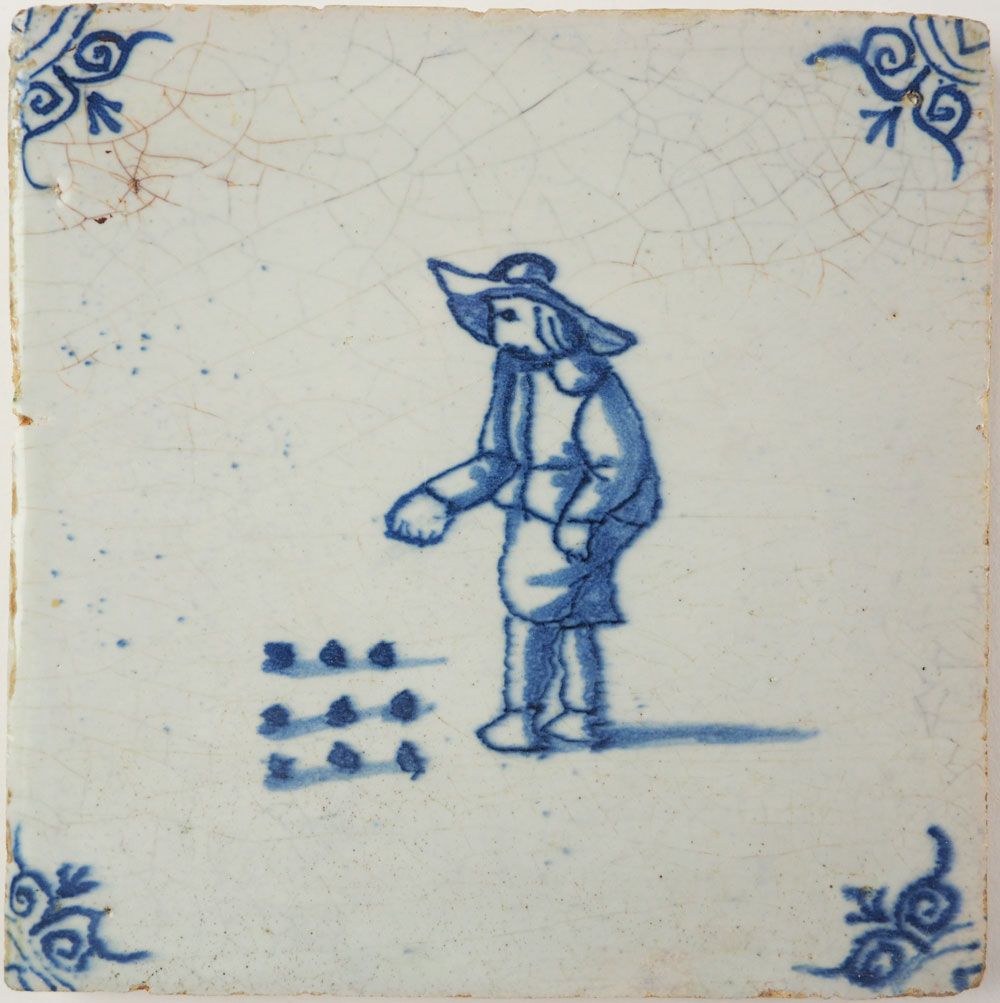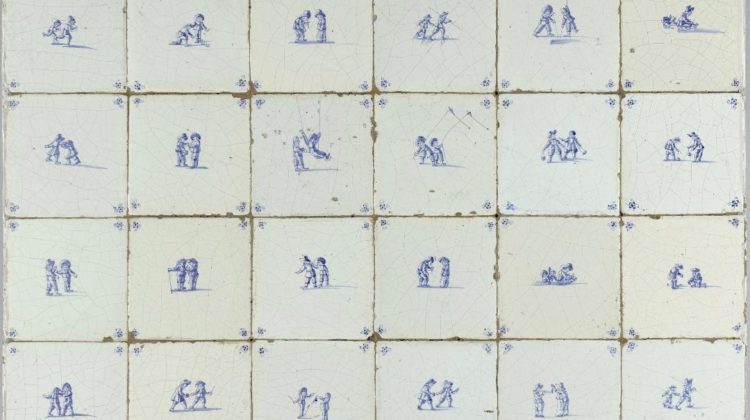
Rijksmuseum Amsterdam. “Tiles with Scenes of Children Playing”; BK-1955-328-A; Netherlands ca. 1680 – 1730; Tin glazed earthenware majolica; height c. 107 cm × width c. 80 cm; Used with Permission
Wie wat bewaart, die heeft wat . Who saves, has something. Old Dutch saying.
400 Years of Playing Marbles & Other Children’s Games
While researching Chapter One, “Where Do Marbles Come From and Why” in our book The Secret Life of Marbles (pages 18 -19) we learned about Pieter Bruegel the Elder’s 1560 oil on panel named Children’s Games. Bruegel’s large panel shows over 200 children playing some 80 “games.” Playing marbles, bowling, knucklebones, and throwing walnuts. Some “games” are highly questionable! The masterwork is in the Kunsthistorisches Museum in Vienna. Take a look.[1]
Specialists tell us that they are unsure why Bruegel painted the panel, but he is not the only artist of his time to give it a shot. Ten years after Bruegel, Flemish artist Maerten van Cleve the Elder painted his oil on oak panel Children’s Games . Van Cleve’s painting is at St-Germain-en-Laye, Museum of National Archaeology in France. Take a few minutes to compare van Cleve’s art to Bruegel.[2] Can you find anyone playing marbles?
From Oil to Dutch Tiles?
Just about the same time that we were writing the book, we also learned a bit about Dutch tiles or “Delftware.” Look back at the first picture in this story. This tile panel, very much like both Bruegel and van Cleve, shows children at play. These tiles were produced about 100 years after the oils on panel, but, to our untrained eye, are remarkably similar to the earlier masterworks. In fact, we know of two different such tiles which do show children playing marbles. We could only imagine that the tiles were derivative, in content at least, of the oils.
However, when we studied Hans van Lemmen we learned better. There is more information on van Lemmen’s website[3 ]about tiles than we ever knew existed! The following information is from his website: van Lemmen “… is a free-lance tile historian, author and lecturer specialising in the history of medieval tiles, Coade stone, Dutch and English Delftware tiles, Victorian tiles and Art Nouveau and Art Deco tiles. He is the President and Honorary Life Member of the Tiles and Architectural Ceramics Society. He undertakes lectures on the history of tiles to antique circles and other interested organisations and groups.”
In his article “Children’s Games on Dutch Delftware Tiles” in the Journal of the Tiles & Architectural Ceramics Society, 3, 1990 (pages 22 – 27), van Lemmen explains that depicting children’s games on tiles is a Dutch tradition which dates to the 15th and 16th centuries. He notes that Bruegel and van Cleve “…show that children’s games were a subject worth recording [italics added], although it doesn’t necessarily follow that Dutch tile-painters used these pictures as direct examples.”
Wat is het?
“’Delftware’ describes all the tin-glazed earthenwares made in the Netherlands and Britain. From the 1600s the most famous was made in Delft in South Holland. The well-known blue tiles appeared about 1620, inspired by the porcelain imported in huge quantities from China. ‘Delft blue’ became world famous, so that it became the name for all blue and white earthenware objects and tiles, even if not actually made in Delft. This pottery was given a tin-based glaze that made it white, glossy and easily painted on.”[4]
Delft aardewerk is certainly not limited to wall cladding and architectural decoration. Delft works include: tableware and cups, vases, flower pyramids, busts, and decorative plates. This list hardly scratches the surface.
Van Lemmen provides details of the needed firing temperature of Delft tiles, how tile-painters go about their job, and so on. And he reports that delftware is still practiced today. In fact, since about 1600 “…their manufacturing techniques have remained virtually unchanged…” until today (italics added).
When most people think of Delftware they think of Delft blue as shown on the tile panel at the start of this story. However, Dutch tiles can also be polychrome. And they have, over the years, depicted a remarkable range of subjects.
Specialists examine the tile subject and corner motifs (delfter-fliese) in an attempt to help date them. Biblical scenes have been extremely important and some believe that the children’s games are allegorical. Children’s games have been depicted for 400 years. There are also mythological creatures, scenes of daily life, landscapes of windmills, houses, and boats, sailing ships (our story Shipwreck Marbles: The Rest of the Story features a Delft tile with a sailing ship) children, women, and men, and, of course, porcelains that reflect Chinese art which became popular after the Dutch opened trade with China.[5]
The Mustard Pot Pub, Leeds, England
We learned about the fireplace surround in the lounge of The Mustard Pot public house from van Lemmen.
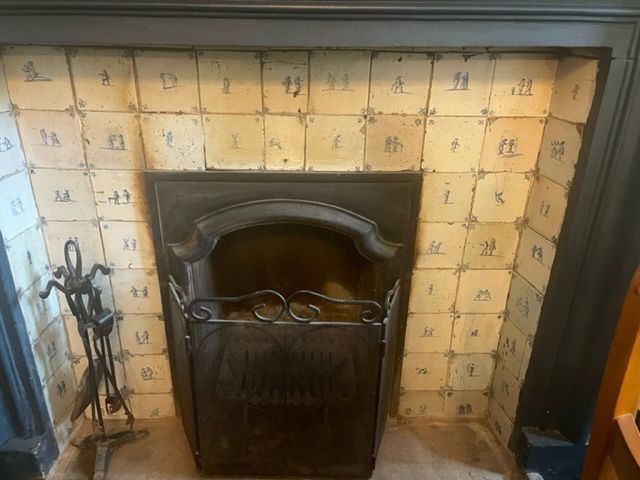
The Mustard Pot fireplace has sixty 17th century Dutch tiles showing children at play. These tiles were imported from Holland. It is interesting that neither English nor Scottish tiles show children at play! This fireplace cladding is an excellent example of how the tile panel at the start of this story could be used for both utilitarian and decorative use. Each and every tile shows children at play.
The Mustard Pot is set in beautiful grounds and it features a family-friendly beer garden. The food is delicious. Built as Clough House in 1750, it became The Mustard Pot in 1979. Thank you Nicole for graciously taking this photograph and sending it to us! Unfortunately, Nicole could not spot children playing marbles on the fireplace tiles, if it is in fact there, nor could we even using an antique magnifying glass. Zoom and see if you can see it!
“Game of Marbles, c. 1660.” On sale by Regts Delft Tiles, Franeker, The Netherlands. Used with permission, Durk Regts.
We Were Hooked On Dutch Tiles!
Since Delft tile making has not changed substantially in 400 years, and since we knew that one or more tiles do show children playing marbles, we wanted one for our collection! We learned that you can buy either antique Delft tiles or brand new ones using American dollars online.
Regts Delft Tiles (https://www.regtsdelfttiles.com/) in Franeker, The Netherlands, is the largest dealer of antique Delft tiles in the world. Their stock ranges from about 1570 – 1900. They are a wonderful place to shop online.
Regts offers an Overview of this marble-playing tile: “This antique Delft wall tile depicts an alternative game of marbles, which was known as ‘Negenkuilen‘ or ‘Koemirollen‘. The game required nine small holes in the ground, which were together placed in the shape of a square. The hole in the center (named the ‘Koemi‘ was slightly larger than the other ones).
How did they play such a thing?
Before the game started, each player had to leave a marble in the koemi. After that the game started. The rules were simple; if a player was able to play his marble in the center hole, he would win all the marbles in there. The four surrounding holes on the corners were known as ‘stekers‘. If one of the marbles of a player ended up in one of those, he had to add the marble to the koemi. If the marble ended up in one of the other four remaining holes, which were known as ‘trekkers’, the player was allowed to take out a marble from the koemi. Simple rules that most surely led to a very entertaining game.
The tile was made around 1660 and is decorated with ‘ox-head’ corner motifs. It is in an excellent condition.”[6] Remember, Specialists examine the corner motifs (delfter-fiese) on a tile in an attempt to help date them.[7] The Oxhead (Ochsenkopf) on the Regts tile dates to ca. 1620 – 1650. We know from both study and experience that while the tile subject and corner motifs can be useful for dating, there are also differences in tiles based on regional preferences over time and, simply, the skill of the regional artist making the Delftware.
A 21st Century 400 Year old Dutch tile?
Next, we wanted to find a modern tile made in the Dutch tradition. In May 2020 we found scenes of children at play, including marbles, at Holland Online https://souvenirsfromholland.com/ in Amsterdam.
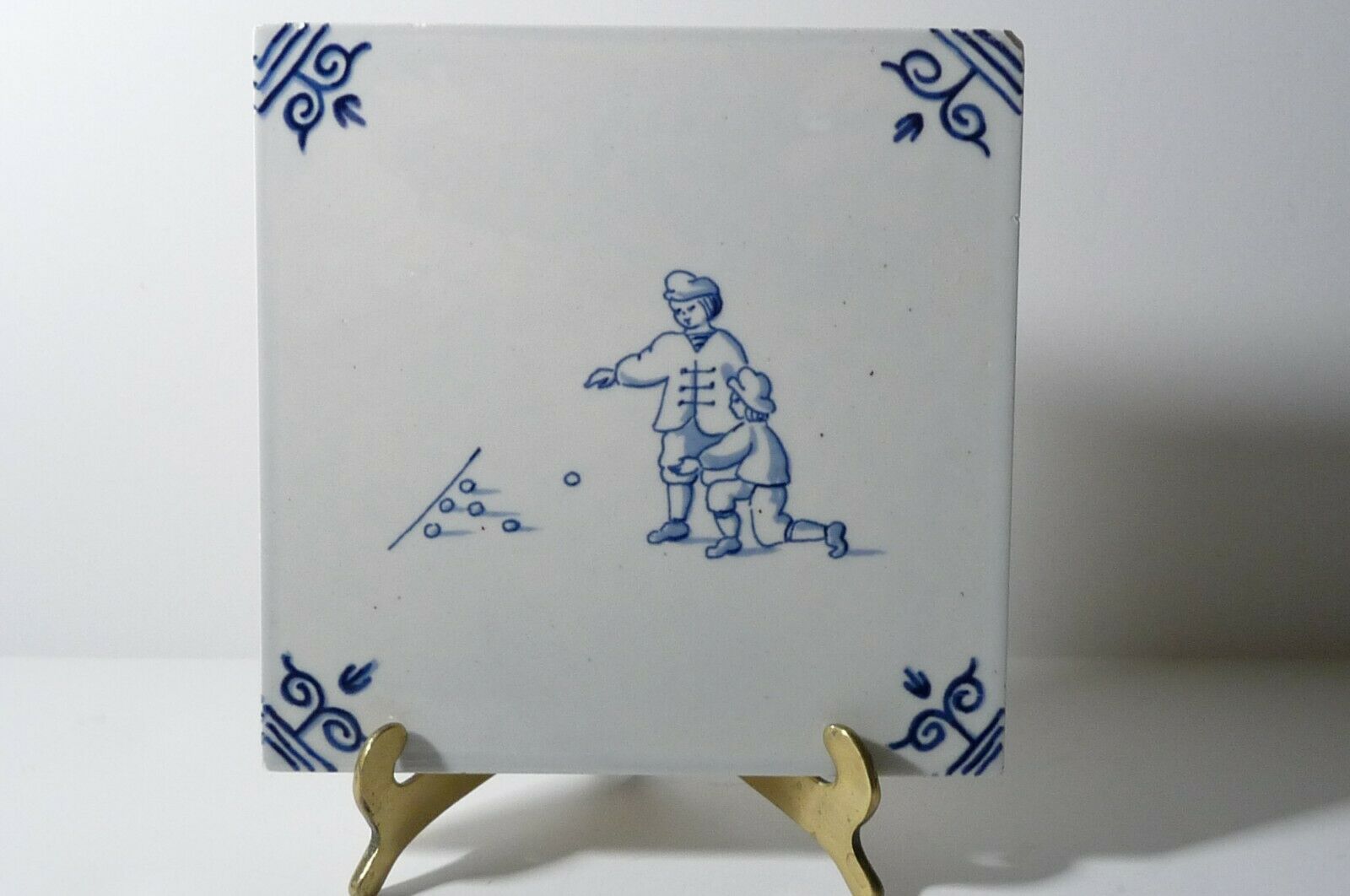 These tiles were historically used as fireplace surrounds, as at The Mustard Pot, and wall cladding in all sorts of places in the Dutch home. Today many people worldwide collect these antique tiles.
These tiles were historically used as fireplace surrounds, as at The Mustard Pot, and wall cladding in all sorts of places in the Dutch home. Today many people worldwide collect these antique tiles.
Some are mounted singly in a wooden frame; often several are mounted on a wall together in the form of a panel. And we have seen them used as the top of a cast iron table.
This tile, with appropriate back stamps, is not an antique but it does show children playing marbles and it is a copy of an antique tile which is part of the Child’s Play series. The original is 5.1” square, dates to about 1780, and it has “spider” (Spinne) or spider head corner motifs. Our tile is 5” square and it is remarkably light at only 150g. The corners show mid-17th century oxheads.
The marbles on the tile appear to be fairly large by modern standards. While it is impossible to say what type stone they are made of, the Dutch did produce stone marbles in the mid-17th century. Check our story Shipwreck Marbles: Found from Wreckage.
The tile shows children playing some type marble pitching game We think the game may have been called “Picking the Plums” (De pruimen plukken).
In their 1866 book The Boys Own Treasury of Sports and Pastimes J.G. Wood, J.H. Pepper, C. Bennett, T. Miller, etc. (London: George Routledge and Sons, np.) explain: “A line is drawn on the ground, along which each player places a certain number of marbles. At this line the players shoot their taws [shooters] in turns from a given point. The marbles knocked off the line become the property of the striker, and the game continues until no marbles remain. The marbles should be placed as close together as possible without touching.”
It is obvious on our tile that the two players are at a “given point”, but one is kneeling and one is standing. We can’t puzzle out who is shooting, and we are left to wonder, since Wood and company don’t tell us, was it okay to kneel or to stand? Needless to say, we are very happy with our Delft tile.
Turkish Delight
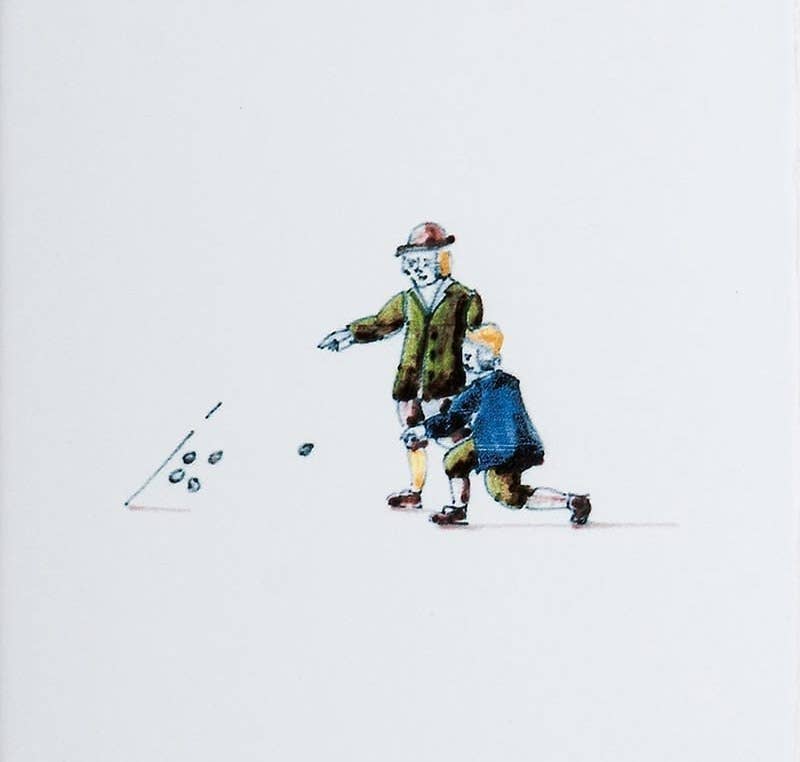
We continued to look for tiles online and we found this second tile. It is similar to, but different from, the first. It, too, is listed as Delft. While it is the same scene as on the first tile, the players seem to have made some sort of transformation! Their clothes now look British! Also, there are no corner mofifs and this one is polychrome majolica.
We ordered this tile online from Country Floors. It was made as a cladding tile for walls or floors, and it is advertised as being appropriate for bathroom, kitchen, foyer, mudroom, and bedroom! Can you imagine an entire room covered in children’s games? What about in a nursery?
This second one is heavy at 450g and it is 6” X 6” X ⅜” thick. It was made in Turkey. “The Delft Ceramic Collection features historic motifs painted on traditional frost-white ceramic tile. … Today, these beautiful tiles are installed on any indoor wall applications, ranging from bathrooms and kitchen backsplashes to feature walls and wet and wine bars. Choose from our specific vintage designs and bring some rich history to your interiors.”
Nederlandse Nationale Historische Schat
Delft tiles are a Dutch national historical treasure. While we would really like to have a Negenkuilen, we don’t see another tile in our immediate future. However we continue to study and learn and we continue to troll museum online galleries looking at Delft tiles all over the world. Give it a try someday!
And we wonder. How many tons of antique tiles have been lost over the centuries in Holland? How many remain in abandoned buildings in cities and towns all across The Netherlands? How many tiles have been restored into homes, pubs, and other businesses over the years?
And we wonder: are there forgotten tiles in a dimly lit lounge in a farmhouse in Giethorn, Volendam, Naarden or other villages and towns across the country? And among those Delft tiles is there a polychrome of boys and girls playing ringer?
- https://jhna.org/articles/homo-ludens-pieter-bruegels-childrens-games-humanist-educators/ 9/14/2022 ↑
- https://www.art-prints-on-demand.com/a/cleve-maerten-van/childrens-games-1.html 9/14/2022 ↑
- http://www.hansvanlemmen.co.uk/burmantofts-tiles/ 9/14/2022 ↑
- Novium Museum, Chichester, England. “Delft Tiles” @ https://www.thenovium.org/article/27461/Delft-Tiles 9/14/2022 ↑
- Some of the games in Bruegel are downright scatological! While we are told that the Dutch tiles are not derivative of the oil painting, you won’t believe what ca. 1650 “Pee Poo” Delft tiles are! Frankly, we cannot imagine where anyone could build cladding with these which would be socially appropriate! ↑
- https://www.regtsdelfttiles.com/antique-delft-tile-with-a-game-of-marbles-17th-century.html 9/2/2022 ↑
- Check http://www.delfter-fliese.de/eckmotive_2.htm 9/15/2022 ↑
Wie wat bewaart, die heeft wat . Who saves, has something. Old Dutch saying.
Comment from: Dr. Gerhard Greiner-Baer, 10/17/2022, from Lauscha, Germany: ” I always think your stories are great! ….As in the Netherlands and Italy, decorative tiles were produced in Germany.” [translation by authors]

